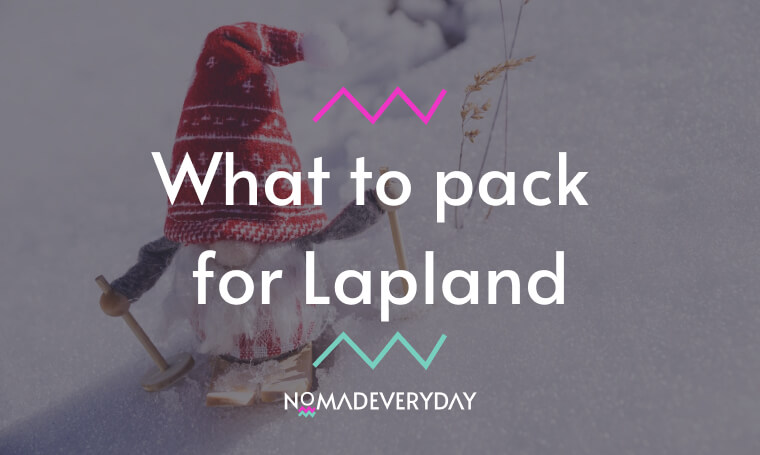In this article, we will list what to pack for Lapland for a perfect winter trip.
You are preparing for your first trip to Lapland and you are wondering what to take in your suitcase? You are at the right place!
To avoid realizing that you have forgotten some essential things when you arrive, or simply to avoid overloading yourself, you will find here the list of basic and essential things that you should take in your luggage.
So here are some tips on how to make the most of our cool and invigorating winters, with temperatures as low as -40°C. It’s true that this is (very) cold but also quite unusual.
The temperatures we normally face are more often between -15 °C and -25 °C.
This comprehensive list of essentials for a trip to Lapland will help you know what to pack, and you will also find some tips and tricks to know before leaving.
What to bring for your trip in Lapland in winter?
If you already have ski equipment and technical clothing, you should be able to get by without having to invest too much in new equipment.
The important thing is to add layers and cover the extremities – head, feet, hands. Here is the list
- Thin socks and thick wool socks.
- Breathable tights or leggings
- Warm pants (avoid jeans) and ski pants
- Long-sleeved thermal (Decathlon, Damart, Odlo…).
- Thick sweaters (fleece, wool or cashmere), preferably with a turtleneck for the coldest.
- Zip-up fleeces or a very thin down jacket.
- Warm Jacket
- Classic gloves (rather thin)
- Scarf
- Hat or a chapka.
- Boots (prefer one size bigger)
- Backpack
- Sunglasses
- Camera
- Flashlights
The essentials
A good rule of thumb is to bring enough clothes for a week before you have to do laundry. Of course, if the trip is only for a weekend, pack accordingly.
Checklists before your trip:
- Prepare your travel itinerary – here are our suggestions for Rovaniemi
- Apply for a visa – if necessary
- Make your vaccinations / PCR tests – check the new entry requirements
- Subscribe to a / Update your travel insurance – optional
- Inform your bank account
- Book your first night in a hotel – obviously!
The Essentials Checklist:
- Passport: make sure it is valid for at least six months
- Visa (if required)
- International driver’s license (if needed)
- Health insurance card
- Credit card
- Cash
- Emergency contact numbers
- Address of your first night in a hotel
- Smartphone + charger
- Small bottle of water + snacks
Top Clothing
For clothing, we recommend some basic clothing that will help you to be warmer during your trip to Lapland.
To be as warm as possible, you should use a layering system. As each layer has a specific function, you will need to bring different kinds of clothes and fabrics.
It is imperative that the body heat stays and not escape but that the air can circulate well between the layers. This is called the 3-layer technique with overlapping.
Top First Layering clothing – To keep you warm and dry
It is the layer in contact with the skin and it should keep you dry and warm regardless of your activity.
It is usually close to the body and you can choose different fabrics like merino wool or synthetic fibers.
Merino wool is natural and warm but dries more slowly. This material has the advantage of being warmer.
Synthetic fibers will keep you dry, even if you move around a lot because they transfer moisture to the next layer.
These thermal garments retain heat and repel moisture to the outside. Different thicknesses are available. The thicker it is, the warmer it is!
Choose the one you prefer the most. If you like being warm all the time we would advise you merino wool however if you practice high-intensity activities we would advise you to take synthetic fiber.
Equip yourself with a pair of tights and a long sleeve t-shirt is a minimum.
Top Second layering – Pleasant and warm
This layer will be in contact with the base layer. Generally, the first layer is closer to the body and the second one is looser.
Like the first layer, it should keep you dry and keep moisture away from your body as much as possible, while insulating it.
The best fabrics for this middle layer will be wool again and fleece. For this one, wool is recommended if you plan to be more active.
This layer works best if it’s made up of two layers.
This second layer should be looser to keep you warm. If it’s not cold, you can wear a big wool sweater, that will do the trick!
Top Third layering – Outer layer: protection against the elements
This is the final layer, the one in contact with the elements. It can be interesting if it is made of a windproof fabric.
A feather-down jacket is a good option even if it is not waterproof. In Lapland, the cold is rather dry so take a really warm and light down jacket.
If you ski, your ski jacket will do just fine.
Down jackets and jackets lined with synthetic fibers are also effective. In reality, your winter jacket is enough for walking around town if you have a good base and mid-layers.
Bottom Clothing
For the pants, ski pants are a good option. Underneath that, you will need to wear a pair of woolen trousers to protect you from the cold and to insulate the heat.
Please note that you will normally be provided with a cold-weather suit and that local people use simple pants in everyday life.
Just take the warmest pants you own and use the equipment provided by the activity organizers to have fun outside and roll around in the snow!
You won’t need this outer layer during the activities because you will be using the equipment provided by the organizers.
For your hands, you can use silk gloves as an under layer, which you layer with winter mittens instead of gloves. Mittens are warmer than gloves.
Shoes for winter in Lapland
You would need boots to walk comfortably in the snow and to adapt to snowshoes.
You should choose shoes/boots at least one size larger than your usual size.
If your feet are too tight in the shoes, you will quickly get cold. Blood must be able to circulate well and remember that the best insulator is air so don’t hesitate to have your feet comfortable in shoes.
Note that the activity organizers will lend you good boots for the activities.
One of the brands to keep your feet warm is Sorel. They are technical and depending on the model, there are really good products.
Salomon shoes are also more sporty, they are made for extreme temperatures (-40°C).
To note also that you will also need those useful accessories
- Beanie / Chapka
- Gloves / Muffles
- Scarf











